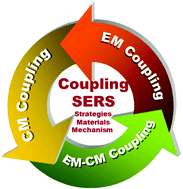Coupling enhancement mechanisms, materials, and strategies for surface-enhanced Raman scattering devices
Abstract
Surface-enhanced Raman scattering (SERS) has become one of the most sensitive analytical techniques for identifying the chemical components, molecular structures, molecular conformations, and the interactions between molecules. However, great challenges still need to be addressed until it can be widely accepted by the absolute quantification of analytes. Recently, many efforts have been devoted to addressing these issues via various electromagnetic (EM), chemical (CM), and EM–CM hybrid coupling enhancement strategies. In comparison with uncoupled SERS devices, they offer key advantages in terms of sensitivity, reproducibility, uniformity, stability, controllability and reliability. This review provides an in-depth analysis of coupled SERS devices, including coupling enhancement mechanisms, materials and approaches. Finally, we also discuss the remaining bottlenecks and possible strategies for the development of coupling-enhanced SERS devices in the future.



 Please wait while we load your content...
Please wait while we load your content...